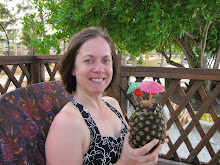Monday, May 3, 2010
Jakarta trip
3 wheel taxi
So, last Sunday I made the trip to Jakarta. I had heard a lot about Jakarta and almost all of it came down to it's a very crowded city, 12 million people! Most of the stories were about how horrible traffic is and guess what the traffic truly is horrible. I'm convinced a few strategically placed traffic lights would do a world of good, I did not see a single light. Ex-pats don't drive in Jakarta they have drivers and with good reason! They also have guards and high walls around their homes, it is a little intimidating. As you can imagine with that many people there is a lot of poverty and so there is a lot of petty theft. So, they have guards. With all of the staff: driver, guards, gardener and housekeeper there is not a lot of privacy. I think that would take some getting used to. I certainly did not feel unsafe at any time, but I did have big round eyes watching everything. Some Jakarta pics:
My goals in visiting Jakarta as 1) to visit Rene Derewetzky 2) Have Rene educate me on Indonesia and the textiles made there 3) In exchange for my education I was to help Rene get her naked loom dressed and help her determine why she has tension issues. All 3 goals were met, yea!
The Loom - The Derewetzkys moved to Jakarta over 2 1/2 years ago and her loom has been naked since they moved, gasp! She warps sectionally, which I have only done a few times. Rene had wound all of her spools ahead of time. She is one of those weavers who over thinks things and worries about every tiny little placement, she likes the threads to be like soldiers, Rene was convinced that her tension issues had something to do with user error. Her loom is a 20 year old AVL modular 4 shaft loom, it has a brake that is a friction brake on the back and nothing on the front, you can advance and it's supposed to tension itself with the back friction brake and a spring. Well, that did not work and I diagnosed this as a loom problem, not the user at all. Rene had purchased an optional traditional brake which was installed after I left and as of today the report is even tension, she is thrilled. I hope she has many more well tensioned warps :)
My textile education:
Day One- was a meeting of the Indonesian Heritage Society's textile study group. The meeting was at Rene's and they were culminating their studies with an indigo dye pot. They dyed scarves that they had stitched resists on. I enjoyed meeting the ladies and learning about their studies.
Day Two we went to the National Museum of Indonesia. They had wonderful large maps of Indonesia which show the islands, their geography and the diversity of the people living there. Some Indonesia facts - there are something like 300 + languages, the government has attempted to unify them with one language, Bahasa Indonesian. There are over 17,500 islands in the archipelago, 70% of the people are Muslim. It's no wonder the government has a difficult time governing the country! Our tour ended in the newly re-opened Textile room, yea! They had some lovely pieces on display with good educational information showing equipment used and describing the different techniques. As far as cloth Indonesian cloth most the techniques primarily used are batik (wax resist on already woven fabric, some hand drawn and some stamped), ikat (tied resist prior to weaving, they do warp ikat, weft ikat and double ikat) and pick up designs.
Day 3 was spent shopping, we went to 3 shops that sell a variety of textiles made in Indonesia. Of course I wanted to support these people so I purchased a good bit, but I wanted more! Lots of gifts!
Rene in Sumba shop with board where the warp is wound then resist tied for ikat.
The picture below is a close up of the textiles on the table. They are all from Sumba and are either warp ikat, songket or a combination. I purchased the piece in the foreground which is an all indigo hinggi, the center is warp ikat, it has songket bands and then along the top and bottom a smaller band that is made on a separate back strap loom with the fringe from the warp used as the weft on the small band, this attaches the large piece to the small piece. Very cool. These pieces are used for a variety of purposes including burial so they are quite large.
Day 4 was spent at Rene's house. We finished dressing the loom and rewarded ourselves with a show and tell of Rene's lovely collection. The photo below is some of Rene's favorite batiks.
Rene's plan to educate me was perfect. I now know roughly the different types of textiles from some of the islands. I can now decide from this knowledge where I most want to go to see the actual cloth being produced. Now where shall I go? I'm thinking Bali (beautiful batiks, weft ikat and double ikat) and Sumba (hinggis with warp ikat or combined with songket pick up).
Now back to the loom!
Songket from Sumba on a back strap loom. This was being demonstrated at the shop where I purchased my hinggi.
Subscribe to:
Comments (Atom)










